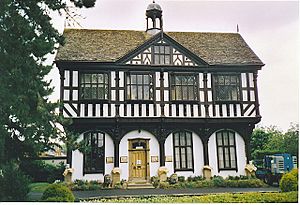John Abel facts for kids
Quick facts for kids
John Abel
|
|
|---|---|

The Grange at Leominster, designed and built by John Abel
|
|
| Born | 1578/79 Sarnesfield, Herefordshire, England
|
| Nationality | English |
| Occupation | Carpenter |
John Abel (born 1578 or 1579 – died January 1675) was a skilled English carpenter and mason. He was given the special title of 'King's Carpenter'. John Abel was famous for building many beautiful structures, especially using a style called Half-timbered construction. This style was very popular in the West Midlands area of England.
John Abel was born in a place called Sarnesfield in Herefordshire. He was a Catholic, like his wife Johanna. Being Catholic was sometimes difficult in England back then. John Abel married twice. We don't know much about his second wife. He had one son, also named John, who later became a churchwarden in Sarnesfield.
What John Abel Built
We don't know much about all the buildings John Abel worked on. Some local stories say he built things that were actually made before he was born!
His first known project was in 1625. He was hired to build Lady Hawkins' grammar school in Kington. John Abel provided all the materials for this school and was paid £240. This building was a bit different from his later work because it used some stone. Parts of the stone windows and ceiling beams from the original school still exist today.
In 1633, John Abel was hired again. This time, John, 1st Viscount Scudamore, asked him to fix up Abbey Dore Church. This church used to be a Cistercian monastery in Herefordshire. Abel finished the work in March 1634. The church is still a great example of Abel's work today. It also shows a special style of church design from that time, called Laudian architecture.
We don't have records of Abel's work for the next 18 years. Then, in 1652, he was paid £30 to create a new building. The original design for this building still exists. It is kept at Tyberton Court, where the work was done.
John Abel also built market houses. These were important buildings where people bought and sold goods. He built them in Brecnoc (in 1624), Kington, and Lemster (in 1634). The Lemster market house is now called Grange Court in Leominster. It originally stood in Broad Street. Later, a man named John Arkwright bought it and moved it. He rebuilt it in 1856. Today, it's a visitor attraction, cafe, and event space. Many people think it's one of Abel's best works. It is built in the Renaissance style.
Sadly, the Kington market hall was pulled down in 1820. We don't know what it looked like.
All of Abel's market houses were made of timber. They often had long religious messages carved into their walls. Some of these messages can also be found in his work at Dore Abbey. Even with all the detailed carvings, Abel's style is often described as "restrained," meaning it was elegant and not too flashy.
Because his building style was so consistent, experts believe John Abel might have also helped restore churches in Vowchurch (in 1613) and Monnington Court on the Wye.
Helping in Wartime
In 1645, during the Civil War, John Abel was in Hereford. The Scottish army was attacking the city. King Charles I and his soldiers were inside the city walls. They needed mills to grind grain for food and to make gunpowder. The enemy had burned down the city's old mills.
But John Abel was able to design and build a new mill! Because of this, the King gave Abel the special title of 'King's Carpenter'. Sir Barnabus Scudamore even said that Abel was the only person in England who could build these important powder mills.
Abel also created a wooden tank, which was like a moving shelter, called the "Sow." Scudamore planned to use it against the Parliamentarian soldiers at Canon Frome in October 1645. However, the device was never used in a real battle. It was captured by enemy soldiers before it could be deployed.
Stories and Legends
John Abel is often linked to the Hereford Market Hall. However, history shows that he probably didn't build it. In 2008, an expert named Nick Molyneux said that the building's style was different from Abel's usual work.
There's also a legend about Dore Abbey Church. The story says that Abel found, cut down, and used all the timber for the church in less than five months! But historical records show this isn't true.
Even though there's no proof he worked on them, John Abel's name was often connected to buildings in many other towns. These included Weobley, Abbey Dore, Tyberton, Stretford, Orleton, Pembridge, Ross-on-Wye, Ledbury, and Hereford.
His Final Years
John Abel died in January 1675. He was buried in Sarnesfield on January 31st. He was 97 years old! He even wrote his own epitaph (a message on a tombstone) and built his own tomb.
His tombstone read:
"This craggy Stone covering is for an Architector's Bed
That lofty Buildings raised high, yet now lyes low His Head
His line and Rule, So Death concludes, are locked up in Store
Build they that [who] list, or they that wist, for He can Build no More
His House of Clay could Hold no Longer
May Heavens joy frame (build) Him a Stronger
Vive ut vivas in vitam aeternam."—John Abel
Later, in the Victorian era, Abel's tomb was fixed up. The epitaph was changed a little bit. In 2001, a new effort began to restore Abel's tomb once more.

